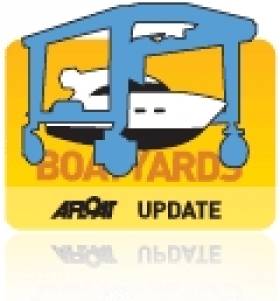Displaying items by tag: Paul Adamson
A former Dun Laoghaire Harbour based Sailing School instructor will lead a new Oyster Yachts management team following the purchase of the luxury boat builder after it went under in February, according to British media reports.
YBW.com reports here, that Richard Hadida has purchased Oyster Yachts and all of its subsidiaries and has brought the owner of one–time Dun Laoghaire Harbour–based sailing school, Sailing West, Paul Adamson on board.
Adamson and his wife Audrey sailed around the world from 2012 to 2014 working professionally for ex Formula One Team Boss, Dubliner Eddie Jordan and prior to that ran the Sailing West Sailing School based at Dun Laoghaire's ferry terminal.
More recently, Adamson has been working as a 'motivational speaker', details as per his website here.
As Afloat.ie reported at the time, the British luxury yacht builder stopped production in February with the loss of some 380 employees at its UK sites at Southampton and Wroxham in Norfolk after the Dutch private equity firm, HTP Investments, announced it would no longer continue to financially support the company.
Hadida is now forming a management team, led by Oyster skipper Adamson, who captained Eddie Jordan's Oyster 885, LUSH in the Oyster World Rally in 2014.
Adamson was also a regular competitor on the Dublin Bay SB20 Sportsboat circuit.
Hadida, who regularly sails on LUSH, told Yachting Monthly he has used his own personal fortune to buy Oyster and all of its subsidiaries, including Oyster Palma and Oyster Newport in the USA.
"Every part of the business, including brokerage and chartering, I plan to bring back to life,' he noted. 'I am not looking to flip it, there is no exit planning, I am in it for the long run, it will be a lifetime business."
His first priority will be on the 26 customers whose Oysters were in build when the company closed its doors.
"We are hoping to start employing people as of tomorrow. At the moment, we have boats in every stage of build from the mould to almost complete and we need to get people on these boats and building them fast. I want to get those yard doors open and start building boats again," stressed Hadida.
Adamson, who will act as 'Chief Transformation Officer', added that the 26 customers with Oysters in build will get exactly what they ordered.
Eddie Jordan's New 155–foot Sunseeker Super Yacht Nears Completion
#sunseeker – Is this the biggest boat owned by an Irishman? Sunseeker's largest ever yacht for Irish Formula One mogul Eddie Jordan has been revealed this weekend at Poole Quay in Dorset, the Bournemouth Echo reports.
The 155–foot yacht, reported to be worth £32 million, was painstakingly moved out of the shed by Sunseeker staff on Saturday and took more than an hour to move the short distance into the yard.
Eddie Jordan has been enjoying a lot of time on the ocean waves of late. Afloat previously reported (this time last year) on the start of Jordan's Round the World Rally. He was joined on that voyage by Dun Laoghaire sailing school instructor Paul Adamson on the Oyster 885, Lush, for the first ever Oyster World Rally.
Meanwhile in Poole, Stewart McIntyre, Managing Director at Sunseeker, whose Irish agents are MGM Boats in Dun Laoghaire, said yesterday: "This is an extremely exciting time for Sunseeker as we inch ever closer to the completion of the 155 Yacht.
"This is the biggest project we have ever undertaken and since the announcement of its build it has been the talk of the industry.
"We are incredibly proud of what we have created and look forward to showcasing it to the world."
The impressive accommodation can cater for 12 guests and 10 crew, and has an on board nightclub, a panoramic viewing area, a dining area, bar and its own garage for jet skis.
The largest luxury boat ever built by the company had to be moved using a radio controlled multiple wheeled unit from its build shed onto the quay at Poole for the final fitting out.
An extra radar mount was needed to complete the boat but it was far too tall for the current shed so the boat will have to spend at least one or two more weeks on the harbourside before it can be finally launched into the water.
More from the Bournemouth Echo here































































